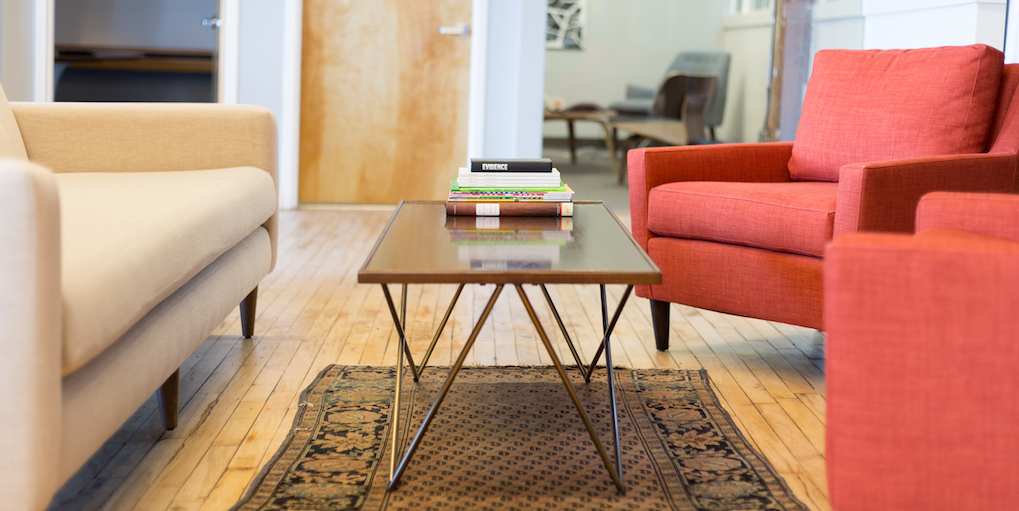
You’ve heard it all before: design is one of the fastest-growing professions today. Just look at the popularity of bootcamps like General Assembly, or Chicago’s own Designation Labs. But a Google search for “design jobs” gets results for everything from furniture designers to sound and video designers to UX/UI design “unicorns”.
Designing for user experiences sometimes necessitates thinking about all of those things at the same time, whether we’re designing a website or designing user experience teams within a larger organization. While Fuzzy Math is an expert at both, we wondered… what’s the best way to explain what exactly it is that we do?
So we asked our designers just that. How do you explain your job to your family and friends?

I start with a question: “Have you ever opened an app or a website and thought, ‘wow, this is terrible!’ and closed it?” Everyone says yes, and sometimes people will have a recent example. Then I get to explain that I get hired to figure out why sites like that don’t work and how to improve them.

If I feel like they would care about the full explanation, I break it down into parts. First, what is “user experience”? Well it’s basically how people engage with products. Learning to use and then continually using something should feel comfortable and simple. So user experience designers are the people who make sure products actually are comfortable and simple to use. But then there’s the question of what do I actually do–like what things go into that? And then I’m like, well, research and talking to users about their expectations and desires for the product. It can be designing how screens look and testing designs with users. At this point, either they get the gist of it or they don’t. If they don’t, I default to “kind of like web design mixed with psychology.” That’s also my one-liner explanation for what I do.

The back-of-the book version is that I’m a visual designer for a company that helps make apps, websites, and other digital tools more intuitive and user-friendly. I use color, fonts, and imagery to make the most important information — and what you can do with it — stand out.
If that interests them, I might talk about building visual systems that can adapt for different types of content across different devices, or choosing colors and fonts that are legible by people with low vision or color blindness. How what I do is just as much about problem-solving and providing access to information as it is about making something “look cool.”

I usually start by reminding the person to remember that like all things, someone has to make design decisions! I think that people forget that when someone creates a website or an application, there’s thought and intention (hopefully) behind the placement of content pieces on the page. That’s where we come in.
I ask them to remember a time they were frustrated or couldn’t understand a website/application. I talk about how we design for the intended human who will be using the site in question. We want to know their needs, wants, and priorities. These insights inform us how to build wireframes which are essentially blueprints that we build from the feedback we receive (that’s the UX side.)
Once wireframes are done, the visuals team takes over to use our knowledge of color theory and hierarchy to further reinforce areas that we’d like the user to pay attention to. That’s skimming the surface, but if they want to know more I’ll go back and go into further detail.

I don’t often talk about what I do for work. But, If people ask about what I do for work I usually keep it pretty short and high level, mainly because I feel like it is hard to explain what we do in a way that can keep someone engaged fully if they don’t understand a bit more of the details. I think what we do is interesting, (we hopefully are in this field because we enjoy it), but with anything, if you don’t understand a bit of the knitty-gritty it is hard to really fully comprehend in a way that connects with people. In my case leading people to drift off in a conversation, this of course just could be a problem with when I talk in general. 😝 Long story short, I typically just say “We talk to people who use applications, like *fill in some application or tool they most likely use* and try and make it better. I make it look pretty.” If I am working on a particularly interesting project for a matter I think could be found to be interesting to the person I am talking with, I may choose to talk about that instead (NDA conscious of course).

I normally throw a series of phrases or keywords until I get a head nod. I always start with “Fuzzy Math provides user experience design”. Then I move into some combination of…. “We make software easier to use. More usable. We design digital products like a banking application. Think about signed-in websites (a bank wouldn’t really hire us to design their website but they would hire us to design the signed-in experience where you manage your money). Workflow applications. Business tools and applications. Website but not like a company website.”
But the best way I’ve found to explain what we do is have an exchange starting with a simple question:
Me: “What’s your job and do you use a computer for it?”
Them: “I am a _____”
Me: “Cool. What software do you use every day?”
Them: “I use software Y.”
Me: “Do you like software Y? Well if not, the company that makes software Y would hire Fuzzy Math to do research with people like you to understand how to make it easier for you. And then we design it.”
Them: “What do you mean by design?”
Me: “Like the actual screen you see in from of you. We design that.”
Of course if they don’t use a computer or are still confused I go back throwing out random words until something sticks.

I typically start with a broad explanation, like “Fuzzy Math designs software,” and slowly move into more specifics about UCD, design research, process design, wireframes, visual design, etc. until their eyes glaze over. The second they start to look like I’m explaining a math equation, I mention how fun I think it is and try to move on to the next topic.
There is usually an “ah ha!” moment when I mention how we talk to end users of the software and try to design for their needs. I’ll usually get a comment about something they have to use at work that is the worst, or maybe about how they hate some new feature in a mobile app, and I mention how that company could hire Fuzzy Math and we’d make it better. We both nod and the world is a wonderful place for a couple shining moments. Other times they ask me to help troubleshoot an issue with their computer and I yearn for the days when I worked at the Brookfield Zoo.
—
So, how well do those explanations fit? We also asked our families how they describe what we do.

“My brother makes websites more user-friendly. Threadless asked FM why customers were filling the cart and not purchasing. He researches and figures out how to make sites better.”

My mom generally just tells people that I design websites.
—
Yeah, that sounds about right.
How do you explain UX to non-UXers?